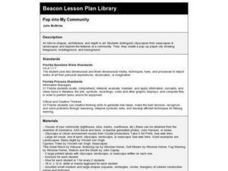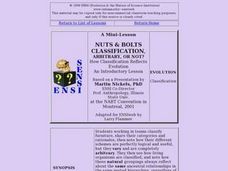Curated OER
Why Does My Body Smell?
Fourth graders investigate how germs spread among people. In this health lesson plan, 4th graders discover the causes of infection and proper hygiene methods.
Curated OER
Gas Law Program
In this chemistry learning exercise, learners complete an online calculation focused upon the Law of Gases. The sheet requires the right kind of internet browser.
Curated OER
This Land is Your Land: Volunteering in the Community
Students discover what a Relief Office does. For this volunteer lesson, students investigate what a Relief Office does, and who helps run it. Students discuss ways he/she could become a volunteer.
Curated OER
IDENTIFYING AND SORTING BEARS
Students study the difference between living and nonliving bears by classifying pictures of bears and placing them on the appropriate posterboard. Given pictures of bears, students recognize types of bears by placing the pictures correctly.
Curated OER
Child Labor Laws in America and Nebraska
Students research child labor laws in Nebraska and America. In this child labor lesson, students examine primary and secondary sources regarding legislation on child labor and create posters that highlight the laws of 1907 and 1910.
Curated OER
Writing Introductions
In this writing introductions activity, students read about 4 types of introductions, then analyze 6 examples and interactively write comments about each one.
Curated OER
Dig In! A Study of the Earth's Crust
Students write a praise chorus and discover the composition of the Earth's crust. In this Biblical creation and the Earth's crust lesson, students read a praise passage from Psalms and perform a choral reading. Students...
Curated OER
Our Land
Students recognize the difference between public and private property. In this public and private lands instructional activity, students discuss the places mentioned in the song "This Land is Your Land." Students create a T-chart showing...
Curated OER
Pop Into My Community
First graders distinguish cityscapes from seascapes and landscapes and explore the features of a community. Then, they create a pop-up paper city showing foreground, middle ground, and background.
Curated OER
Create Your Own Fog
Students conduct an experiment. In this science lesson, students create their own fog. Students observe the results.
Curated OER
Blakesley Hall
In this history worksheet, students read about Blakesley Hall, which is a home built during the 1600s in Yardley. Students learn about the different rooms in the hall and the layout of the home.
Curated OER
Kingdom Animalia ~ A Look at the Five Major Classes
Biological taxonomy masters examine the five main classes under phylum chordata. Pupils compare and contrast the identifying characteristics of the various organisms. They explain why taxonomy is important in classifying organisms. You...
Curated OER
Nuts & Bolts: is Classification, Arbitrary, Or Not?
Students, in groups, classify furniture, share their categories and rationales, then note how their different schemes vary, perfectly logical and useful, but completely arbitrary.
Curated OER
Outlines and Organization: Sample Outline
Provide your essay writers with a sample essay outline. Richly detailed, this two-page handout not only describes the necessary parts of an outline, but also explains the purpose of each section. A model outline is also included.
Curated OER
Sand Travels
Learners examine how sand is formed by erosion and that it can be moved by streams, rivers, and ocean currents in this unit of lessons. They study waves and currents, and structures that change how sand moves by creating story charts,...
Stanford University
Corroboration
How do historians corroborate the information in a primary source document? They use the questions features on this poster!
Curated OER
Environment: Arctic Climate and Geoscience
Students conduct a thorough investigation of the Arctic and how climate change affects it. After listing a KWL chart, they record their findings on a bulletin board. Finally, in an Arctic Alive! interactive lesson, students take a...
Curated OER
ECONOMIC SYSTEMS
Young scholars list and explain the three types of economic systems as well as the three economic questions that every economic society must answer at one time or another. In addition, they identify the five features of our market economy.
Curated OER
Economic Decisions
Students practice decision-making skills by planning vacation, including all proposed expenses. Students distinguish between needs and wants, identify difference between goods and services, and describe economic resources used in...
Curated OER
Hatchet
Fourth graders read the novel Hatchet. In this novel lesson, 4th graders begin reading Hatchet. Students break into groups, view the cover of the book and predict what the plot will be. Students write their list on paper. Students...
Curated OER
Health and Safety
High schoolers analyze colors and the reasons they are used in preschool room setups. They examine preschool setups, safety procedures, and the immunizations required for preschool.
Curated OER
Thank You Ma'am Langston Hughes Process of Discovering Theme
Middle schoolers identify the elements of the plot and identify and express this story?????™s theme.
Curated OER
Dell House Dig
Students demonstrate basic procedures for archeological excavations. They participate in an archaeological dig exploration off of Blackhawk Island in the Wisconsin River where the Dell House once stood.
Curated OER
The Mesozoic Era
Sixth graders recognize that the Earth was different in different eras. In this Mesozoic Era lesson, 6th graders compare the time frame of the different eras and how long they lasted for by graphing them. Students study the...
Other popular searches
- Intro to Business
- Intro to Poetry
- Intro to European Geography
- Intro to Credits
- Intro to Graphing Equations
- Intro to Language
- Intro to Human Skeleton
- Intro to Business Marketing
- Intro to Biology
- Intro to Frequency Tables
- Intro to Musical Form
- Intro to Computers























